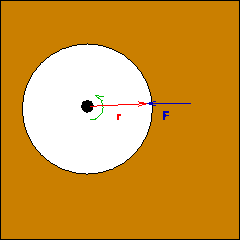
First think about what a force does. If you apply a force to an object, it'll have a tendency to go in that direction. Now you want to know what kind of thing you apply to twist an object. For example, if you have a merry-go-round, you can apply a force to the rim of it. If the force is towards the center, it won't move at all.
If it's tangent to the rim, it'll move a lot more easily.
Also if you apply a force close to the center, it won't move much.
Given this, we see that what causes a rotating object to twist is not just the force, it depends on where the force is being applied and it what direction. So now we define the torque to be
![]()
![]() is the defines the point that the force is being applied.
Does this make sense? Well the dependence on r means that
the larger r, the more effective the force will be in twisting
the object. The cross product makes sense too. If
is the defines the point that the force is being applied.
Does this make sense? Well the dependence on r means that
the larger r, the more effective the force will be in twisting
the object. The cross product makes sense too. If ![]() and
and ![]() are in the same direction, you get no twist, if they're
perpendicular, you get the maximum effect. The whole
thing seems pretty sensible. Now the direction of
are in the same direction, you get no twist, if they're
perpendicular, you get the maximum effect. The whole
thing seems pretty sensible. Now the direction of ![]() is
a bit odd at first sight. It's perpendicular to both
is
a bit odd at first sight. It's perpendicular to both ![]() and
and
![]() . Think about appling torque with a wrenth to undue
a screw. The direction of the torque is in the direction of the
bolt. It defines the axis that you're attempting to twist the
object.
. Think about appling torque with a wrenth to undue
a screw. The direction of the torque is in the direction of the
bolt. It defines the axis that you're attempting to twist the
object.
But does our analogy we translational
motion hold? If I is like the mass m, and ![]() is like a,
then the analog to f = ma should be
is like a,
then the analog to f = ma should be ![]() . Is
this true?
. Is
this true?
Let's try to see if this works out. The strategy is as follows. We'll consider some object like a disk rotating about a fixed axis. We'll consider it to be two dimensional for simplicity. That way we don't have to worry too much about the vector nature of the problem. We'll divide it up into lots of tiny masses and understand each one individually. Then we'll sum up the effect from all of the.
First of all consider just
one point mass circling at a distance r from
an axis. Let's say we apply a force ![]() to this particle.
Both
to this particle.
Both ![]() and
and ![]() are both in the x-y plane, so their
cross product always points in the z direction.
are both in the x-y plane, so their
cross product always points in the z direction.
![]()
Here ![]() is the tangential component of
the force.
is the tangential component of
the force.
But ![]() So plugging this in we have
So plugging this in we have
![]()
The moment of inertia for a single particle is just ![]() , so
we get
, so
we get ![]() for this one particle. Now let's
say you've got a jillion particles. To each one you apply a
different torque
for this one particle. Now let's
say you've got a jillion particles. To each one you apply a
different torque ![]() , then the sum of all these torques
is just
, then the sum of all these torques
is just
![]()
Now we've understood the analogous quantity to the force, let's do the same for momentum.